Tipos de horarios
Son los distintos tipos de horarios que puede haber en la empresa. Hay días que son festivos y no hay que trabajar, hay días que son de fin de semana y tampoco hay que trabajar, jornadas con horario de mañana, jornadas con horario de tarde, etc.
También hay jornadas en los que los trabajadores comienzan por la tarde y terminan su jornada laboral de madrugada (típico en los bares y restaurantes). Otras jornadas comienzan por la noche del día anterior y terminan a las 07:00 u 08:00 de la mañana.
GesFicher le permite definir los distintos tipos de horarios, asignándoles colores diferentes para que pueda identificar cada jornada de trabajo de forma sencilla. En la opción de calendarios podrá indicar para cada día el tipo de horario que le corresponde.
Los usuarios que tengan permiso de administración podrán gestionar los tipos de horarios.
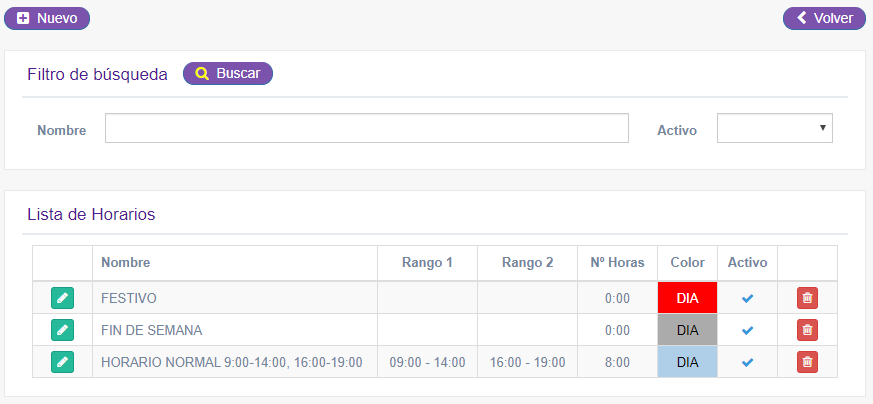
En la pantalla principal del mantenimiento de tipos de horarios podrá dar de alta tipos de horarios y buscar algún tipo ya existente para modificarlo o borrarlo.
Ejemplos
Jornada de trabajo normal de 8 horas
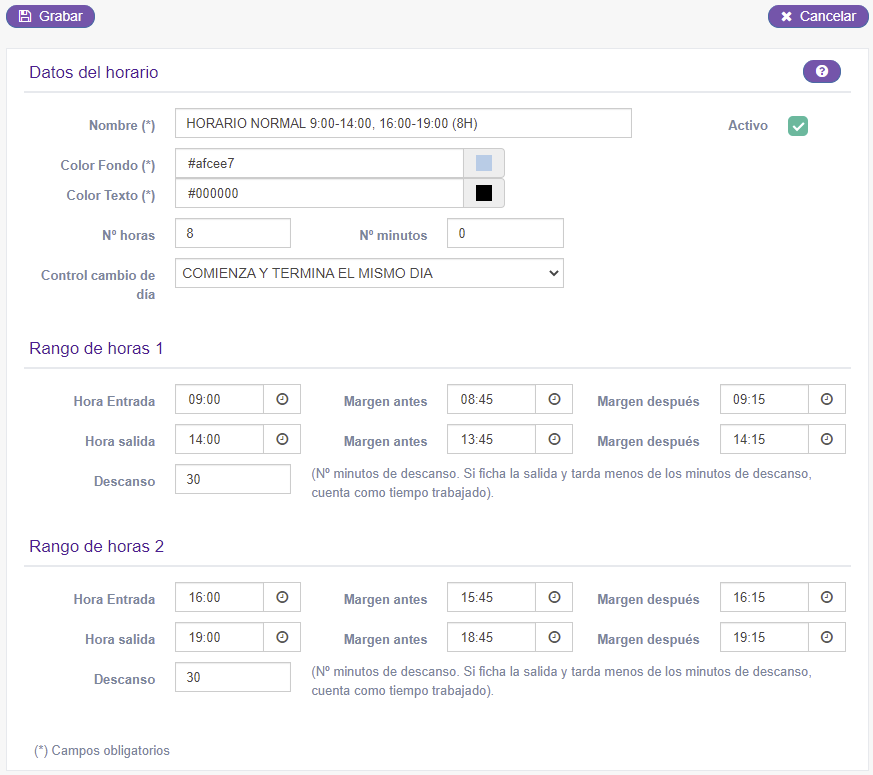
- Se trabaja por la mañana (de 09:00 a 14:00) y por la tarde (de 16:00 a 19:00).
- La jornada comienza y termina el mismo día
- Es una jornada de trabajo de 8 horas
- En la entrada de las 09:00 se da un margen de entrada a los empleados desde las 08:45 hasta las 09:15.
- Se da un descanso de 30 minutos tanto por la mañana como por la tarde. Si ficha una salida en el rango de horas y tarda en volver al trabajo menos de los minutos de descanso, le cuenta todo ese tiempo como trabajado. Si tarda más tiempo del indicado como descanso, el tiempo que se sobrepase no contará como trabajado y deberá recuperarlo.
Jornada festiva
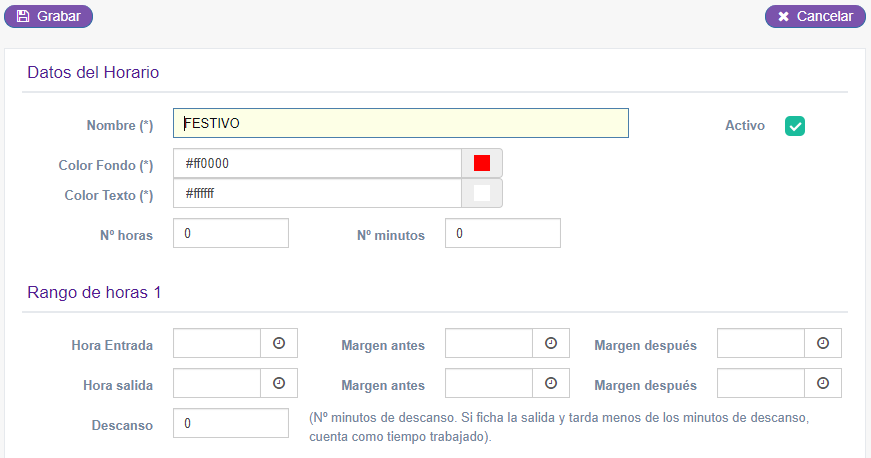
- Se muestra en el calendario en color rojo para resaltar los días festivos.
- El nº de horas de trabajo es 0 horas.
- No es necesario definir ni rango de entrada ni de salida.
Turno de noche
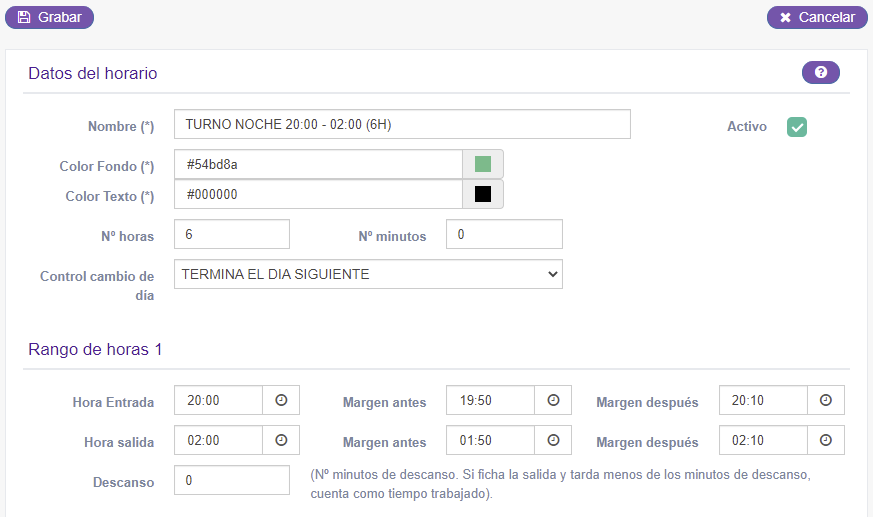
- El turno termina el día siguiente, es decir, comienza a las 20:00 del día y termina a las 02:00 de la madrugada del día siguiente.
- En este caso, las horas computan en el día en que empieza la jornada laboral.
- No se da margen de descanso.
Turno de madrugada
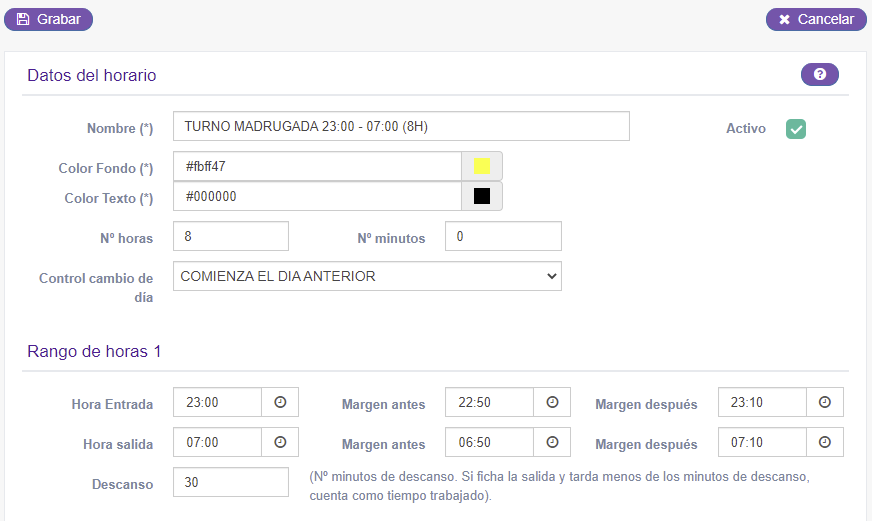
- El turno comienza a última hora del día anterior, es decir, comienza a las 23:00 del día anterior y termina a las 07:00 de la mañana del día en que computa el trabajo.
- En este caso, las horas computan en el día en que termina la jornada laboral.
- Se da margen de descanso de 30 minutos.
Descripción ampliada de los campos del formulario de configuración
- Nombre: Nombre para identificar al tipo de horario (Festivo, Fin de semana, Turno mañana, Jornada completa, etc.).
- Activo: Indica si el tipo de horario está activo o no, para poderlo utilizar en los calendarios.
- Color fondo: Indica el color de fondo con el que se muestra en el calendario.
- Color texto: Indica el color del texto con el que se muestra en el calendario.
- Nº horas y Nº minutos: Indica el horario que se debe trabajar en este horario. Por ejemplo en festivos debería ser 0, en horario de turno de mañana por ejemplo 5 horas y 30 minutos, en horario de jornada completa por ejemplo 7 horas.
- Control cambio de día: Indica si la jornada de trabajo se realiza de forma completa en el mismo día o no. Se permiten varias opciones:
- COMIENZA Y TERMINA EL MISMO DIA: La jornada de trabajo se realiza de forma completa en el mismo día.
- COMIENZA EL DIA ANTERIOR: La jornada de trabajo comienza el día anterior. Es útil para configurar jornadas de trabajo que se desarrollan mayoritariamente de madrugada. Las horas computan el día en que termina la jornada laboral.
- TERMINA EL DIA SIGUIENTE: La jornada de trabajo termina el día siguiente. Es útil para configurar jornadas de trabajo que se desarrollan mayoritariamente por la tarde y noche, por ejemplo el turno de noche de los bares, que pueden terminar a altas horas de madrugada del día siguiente. Las horas computan el día en que se inicia la jornada laboral.
- Rango de horas 1 y 2: Si una jornada está partida en 2 turnos, por ejemplo en el mismo día debe hacer un horario de mañana y de tarde, identifica los datos de los 2 turnos. Si la jornada se realiza en un sólo rango de horas, debe especificar el rango 1 y dejar vacío el rango 2.
- Hora entrada: Hora normal de entrada en el rango de horas. Por ejemplo 09:00
- Margen antes: Hora a la que se permite entrar contando horas trabajadas antes de la hora normal de entrada. Por ejemplo, si se indica 08:45, si se entra a trabajar antes de las 08:45 no contaría el horario hasta las 08:45.
- Margen después: Hora a la que se permite entrar después del horario normal sin que se genere ninguna alerta por llegar tarde al trabajo. Por ejemplo: 09:15.
- Hora salida: Hora normal de salida en el rango de horas. Por ejemplo 14:00.
- Margen antes: Hora a la que se permite salir antes del horario normal sin que se genere ninguna alerta por salir del trabajo antes de tiempo. Por ejemplo: 13:45.
- Margen después: Hora posterior a la hora de salida normal hasta la que se cuenta como trabajado. Por ejemplo, si se indica 14:15, sólo le cuenta como trabajado hasta esa hora.
- Descanso: Número de minutos de descanso. Si ficha una salida en el rango de horas y tarda en volver al trabajo menos de los minutos de descanso, le cuenta todo ese tiempo como trabajado. Si tarda más tiempo del indicado como descanso, el tiempo que se sobrepase no contará como trabajado y deberá recuperarlo.
- Rango de horas 2: Sólo se deberá indicar si la jornada está partida en 2 rangos de horas.
Ejemplo de un horario a turnos. Cómo se refleja en la tabla de marcajes del usuario.

- Lunes 1: Tiene un horario de 8 horas a cumplir de 09:00 a 14:00 y de 16:00 a 19:00. Es un horario normal que comienza y termina el mismo día.
- Martes 2: Tiene un turno de madrugada de 8 horas a cumplir de 23:00 a 07:00 del día siguiente. El marcaje de las 23:00 se hizo la noche del lunes y el marcaje de las 07:00 se hizo en la mañana del martes día 2.
- Miércoles 3: Tiene un turno de noche de 6 horas a cumplir de 20:00 a 02:00 del día siguiente. El marcaje de las 20:00 se hizo la tarde/noche del martes y el marcaje de las 02:00 se hizo en la madrugada del miércoles día 3.
